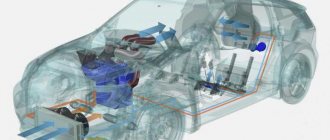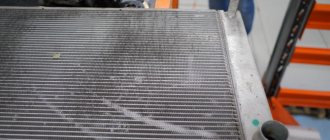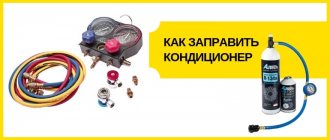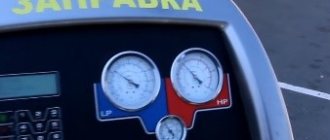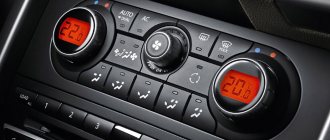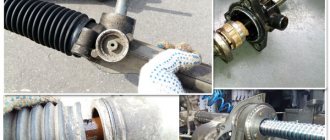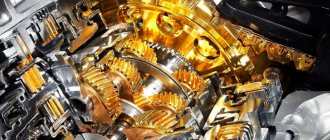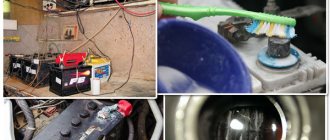Climate control unit
Car air conditioning can work in winter.
The main thing is that it is not very cold outside. Car air conditioning can work in winter. The main thing is that it is not very cold outside.
Physics of the process
The operation of any air conditioner (including a conventional refrigerator) is based on the transition of the refrigerant (freon) circulating through the system from a gaseous state to a liquid state, and vice versa. It is these changes in the state of aggregation that ensure the absorption and release of large amounts of heat (thermal energy).
How to use climate control in a car in winter
- Do not change the air supply until the interior has warmed up, as this may cause condensation or ice to accumulate on the surface of the dampers.
- The air conditioning compressor should be started regularly to carry out preventative maintenance on the rubber seals.
- It is prohibited to turn on the climate control with incorrect settings in relation to air humidity. After all, there is moisture in the air, which, if the system does not work properly, will accumulate on the evaporator and can cause an unpleasant odor in the cabin.
- It is recommended to use only the air conditioner once a week to remove moisture from the evaporator housing.
Air conditioning system diagram
Diagram of an air conditioning system with an expansion valve: 1 - compressor;
2 — condenser (external radiator); 3 - heat release into the atmosphere; 4 — receiver-dryer; 5 - expansion valve; 6 - heat from the car interior; 7 — evaporator (cabin radiator). Diagram of an air conditioning system with an expansion valve: 1 - compressor; 2 — condenser (external radiator); 3 - heat release into the atmosphere; 4 — receiver-dryer; 5 - expansion valve; 6 - heat from the car interior; 7 — evaporator (cabin radiator).
Freon enters the cabin radiator (evaporator) in a liquid state and at a low temperature. Through the honeycomb of the heat exchanger, it actively absorbs heat from the air, simultaneously drying it, and boils, completely turning into gas. In the system's external radiator (condenser), it releases this energy into the environment, turning back into liquid.
Where does the heat come from?
To better understand how climate control works in a car, you need to understand how all its components work individually. Let's start with the interior heater.
Heat is a byproduct of the engine running. In the summer (with the stove turned off), all the heat is released into the atmosphere. When the heater is turned on, part of this heat is used to heat the interior. When the heater is turned on, the tap opens, which is located in the line between the engine cooling jacket and the heater radiator. As the coolant passes through the radiator, it heats it up. Next, you need to distribute this heat throughout the cabin. The fan is responsible for this. Passing through the radiator honeycombs, cold air heats up and spreads through the air ducts throughout the cabin. The degree of heating of the flow can be adjusted by changing the amount of liquid that passes through the heater, and the intensity of the blowing changes by changing the rotation speed of the electric motor. These parameters are changed on the stove control panel. For convenience, there is also control over the direction of the airflow (on the legs, in the face, on the glass). The driver himself sets the priority direction of airflow. For example, in winter, when the car windows are covered with condensation, for a comfortable and safe ride, the priority will be to warm up the windshield and then turn on the airflow for the feet. The driver has to make all shifts on the go, which has a negative impact on road safety.
air conditioning compressor
Liquid freon entering the air conditioning compressor leads to its death.
This is akin to water hammer in an internal combustion engine. Liquid freon entering the air conditioning compressor leads to its death. This is akin to water hammer in an internal combustion engine.
Complete evaporation of freon is critical to the health of the compressor, which circulates it throughout the system. If even a small volume of liquid refrigerant gets into it, it will be fatal. Therefore, various monitoring sensors are included in the control system to eliminate this risk. Based on their readings, the electronics can forcibly turn off the compressor during operation or even prohibit its activation.
Variables
Nowadays, the vast majority of car air conditioners use R134a freon. At atmospheric pressure, it begins to boil already at -26°C. But in the air conditioning system it is under excess pressure. Accordingly, its boiling point will be higher. The transition to a gaseous state in the evaporator is possible at approximately 0°C. In winter, it often happens that freon simply does not have enough heat from the air in the cabin to turn into gas. This is closely monitored by an ambient temperature sensor and an additional climate control sensor in the cabin. Therefore, under certain conditions outside, the control system will prohibit the inclusion of the air conditioning compressor.
Why do you turn on the air conditioning in your car in winter?
Any expert on car air conditioning will tell you that you need to turn on the air conditioning in your car in winter. And user manuals for different car models will confirm this. But why do this?
Scheme of operation of the air conditioning system in the car interior
The fact is that the air conditioning system uses special compressor oil. It is necessary to lubricate the compressor parts and all rubber seals of the system. If it were not there, the rubbing parts in the compressor would simply jam. However, the oil itself does not circulate within the system on its own; it is dissolved in freon, which is its carrier.
As a result, if you do not turn on the air conditioner for a long time (for example, several months in a row, from autumn to summer), the first time when starting up after inactivity, the compressor will run “dry”. This mode can lead to failure or simply significantly reduce its life. And the longer the system is idle, the longer it takes the oil to lubricate all elements of the system again. The more the compressor is “killed”.
Working without lubrication, compressor parts wear out and metal dust settles in the system. It is almost impossible to rinse and clean it - it remains inside forever and will slowly kill even a new compressor.
And looking at its cost, no one wants to change this part (for Priora - 9,000 rubles, for Lacetti - 11,000 rubles, Ford Focus 3 - 12,000 rubles). Therefore, lubricating the system is the main reason why you need to turn on the air conditioning in your car in winter. But the use of the car air conditioner in winter must be correct, otherwise you will not be able to turn it on in the summer.
But in addition to wear and tear on the compressor itself, rubber seals also suffer without lubrication. And if they dry out, freon will begin to flow out and evaporate. Filling in a new one is not as expensive as replacing a compressor, but it is also several thousand rubles. Moreover, the costs will not be recouped yet, because if the cause of the leak is not found and eliminated, the freon will leave the system again and the money will literally be thrown away.
In some articles you can find information that there is no need to turn on the air conditioning on modern cars, because their compressor does not have an electromagnetic clutch, which turns sour and which actually needs lubrication. But these are unrelated facts - the absence of a clutch, which is located outside the compressor, does not eliminate the need to lubricate the rubbing parts inside the compressor.
Several factors contribute to confusion regarding the question “can I turn on the air conditioner in a car in winter?”
- The manuals do not write anything about the fact that you need to start the air conditioner at a positive ambient temperature - no one has ever found an answer why this is not indicated.
- The compressors of most cars manufactured after 2000 rotate all year round and are called all-weather. The work of the compressor to increase pressure and close the clutch and pulley occurs inside the structure - therefore, it is difficult to determine that it has actually “worked” and this complicates the understanding of “whether the air conditioner turns on in winter.”
- Even when the compressor is turned off, the AC lamp lights up in the cabin - we’ll try to figure this out separately.
How often should you turn on your air conditioner in winter?
There is no single recommendation. The average value is once every 7-10 days for 10-15 minutes. The best place to look for this information is in your specific vehicle's owner's manual. In general, this is the only reliable source of information for which the automaker is responsible and risks possible lawsuits. Even if you doubt whether you can turn on the air conditioning in your car in winter, look at what the manufacturer wrote. When it says “turn on,” then turn on and don’t be afraid of what will happen if you turn on the air conditioner in your car in winter. If there is no such information, the final choice is yours. However, remember all the arguments that were given above.
Why can doubts arise at all, because the system needs lubrication? In fact, the air conditioner does not start in cold weather! Yes, even if the A/C light on the panel is on. To enable it, certain conditions are required.
Refrigerant condition
State of the refrigerant in the air conditioner: A...B - compression in the compressor;
B…C - cooling in the condenser; C...D - processes in an expansion valve or unregulated throttle; D...A - processes in the evaporator, the transition of liquid refrigerant into gas. The curved line is the boundary between liquid and gas. State of the refrigerant in the air conditioner: A...B - compression in the compressor; B…C - cooling in the condenser; C...D - processes in an expansion valve or unregulated throttle; D...A - processes in the evaporator, the transition of liquid refrigerant into gas. The curved line is the boundary between liquid and gas.
The pressure in the air conditioning system is monitored by a combination sensor. If the pressure is too low or high, turning on the compressor will be prohibited in order to eliminate the risk of damage. This is done so that the system does not activate, for example, when there is not enough freon in it. An important point: when the air conditioner is running, the freon pressure before the compressor is usually about 3 bar, and after the compressor - about 14 bar. A short time after it stops, the indicators are compared. At 20°C this pressure is about 5–6 bar, but at 0°C it drops to 2 bar. And on some car models, this is enough for the control system to block the compressor from turning on.
Depending on the specific car model, pressure and temperature sensors have different priorities. For example, on many machines the control unit is guided by the readings of an external temperature sensor. If the car is driven into a heated garage from the cold, then even when the pressure in the system physically rises to the operating range, the electronic “brains” will need a little more time to realize the real, and not momentary change in environmental conditions and give the go-ahead to turn on the compressor.
Work algorithm
These systems are designed to make you less distracted while driving. To do this, you set the desired temperature and switch the control to automatic mode, and the computer, reading information from the sensors, decides which unit to start at the moment. In winter, using the automatic mode, the air will first be directed to the windshield and will reach the desired temperature as quickly as possible. Then it will switch to maintenance mode and redirect the flow to the face and legs. Improved versions can dry the incoming air by passing it through the air conditioner evaporator and then through the heater radiator, this will prevent the windows from fogging up.
Summarizing all that has been said, it can be noted that using climate control in winter is not only possible, but also necessary. The interior is heated in the shortest possible time, the air goes through a drying stage (passing through the air conditioner evaporator), which makes movement safe. When moving, there is no need to be distracted by changing parameters, since the computer itself adjusts all parameters in accordance with the climate in the cabin.
Outdoor temperature sensor
The outside air temperature sensor is usually mounted in front of the radiators of the engine cooling system in the area of the lower grille in the bumper.
In summer traffic jams, it can overestimate readings if it is too close to the heat exchangers, and in winter, on the contrary, it can underestimate if the niche is clogged with snow. The outside air temperature sensor is usually mounted in front of the radiators of the engine cooling system in the area of the lower grille in the bumper. In summer traffic jams, it can overestimate readings if it is too close to the heat exchangers, and in winter, on the contrary, it can underestimate if the niche is clogged with snow.
The main conclusion: in winter you can safely use air conditioning. This in no way affects the resource of its elements. The only question is whether the control system of a particular car, which has been trained to play it safe, will approve this. On some cars, the air conditioning compressor will turn on even at negative temperatures outside (slightly below zero). And, for example, on some Fords it will refuse to work when a “snowflake” lights up on the instrument panel (the temperature drops below 3°C). It all depends on the software and design of the air conditioning system of a particular car, that is, its performance characteristics. By the way, service technicians recommend regularly turning on the air conditioner in winter to reduce the risk of souring of the metal pressure plate of the compressor clutch.
The air conditioner protection system is very reliable. It relies on the readings of several sensors and has various safety algorithms. In general, little is known about the reality of compressor startup under unfavorable conditions. But if for some reason this does happen and liquid freon gets into it, then its death will be sudden, and the rest of the system elements will not be affected.
How does an air conditioner work and what are the dangers of turning it on in winter?
Why doesn't the air conditioner turn on in winter?
The air conditioning system of all cars, regardless of age and design, does not turn on at low temperatures. Each automaker has its own settings at what temperature the air conditioning in the car does not work, but most fall within the general range from -5°C to +5°C. Here is the data collected by journalists from the Za Rulem publication from automakers in Russia in 2021.
| car brand | Minimum compressor operating temperature |
| BMW | +1 °C |
| Haval | -5 °C |
| Kia | +2 °C |
| MPSA (Mitsubishi-Peugeot-Citroen) | +5 °C |
| Nissan | -5…-2 °C |
| Porsche | +2…+3 °C |
| Renault | +4…+5 °C |
| Skoda | +2 °C |
| Subaru | 0 °C |
| Volkswagen | +2…+5 °C |
What does this mean? The system design has a freon pressure sensor, which primarily prevents an emergency situation with a high level of pressure. Roughly speaking, he makes sure that the compressor does not “overpump”. But he also has a minimum pressure level, below which he considers that there is no freon in the system at all and also does not allow the compressor to turn on.
At this moment, elementary physics works - the lower the temperature outside, the lower the pressure in the system. At some point (individual for each car manufacturer), the sensor disables the ability to turn on the air conditioning. This is a safety mechanism that prevents the compressor from operating under low pressure conditions.
Why can the air conditioner still turn on some time after the engine starts and reaches operating temperature? Not a single automaker reports the settings for the operation of their air conditioning and climate control systems. But it is logical to assume that the compressor heats up in the engine compartment of the car to the minimum required level and the pressure sensor allows it to start.
But even in such a situation, the air conditioner can quickly turn off, literally 10 seconds after turning on. This is where the evaporator temperature sensor comes into play - if it detects the risk of icing of the part due to the low temperature around, the system will turn off again.
How to turn on the air conditioning in your car in winter
So should you turn on the air conditioning in your car in winter if it still won’t start? Yes, turn it on to drain the oil, and to do this, you have the following options:
- warm up the car well, it will turn on when the dashboard in the cabin is already warm;
- turn it on in any warm room: a heated garage, a warm box, an indoor parking lot, a car wash (by the way, many car owners recommend a car wash).
In this case, you will definitely be able to turn on the car air conditioner in winter and even monitor its operation. On older compressors with an electromagnetic clutch, this is easy to understand, because when turned on there is a click - this is the clutch engaging with the pulley. In modern climate control systems, you can understand that the air conditioner only works in a warm box, after a while checking what air is coming from the air ducts or watching the revolutions on the tachometer - they should increase.
What should you warm up?
Modern drivers love comfort very much, so they install additional options on their cars, for example, heated seats, windshields, etc. Even in a cold interior, heated seats allow you to immediately feel comfortable. It is turned on immediately after the engine is started.
If one stove is not enough, especially in large cars, an additional heater is installed for passengers. Often placed in minibuses, as well as taxi drivers and drivers of heavy trucks.
Still, the stove is an extremely important element in a car in winter. You cannot drive your car without a properly functioning heater. This is both a guarantee of your health and your safety.
Photos from Internet resources
